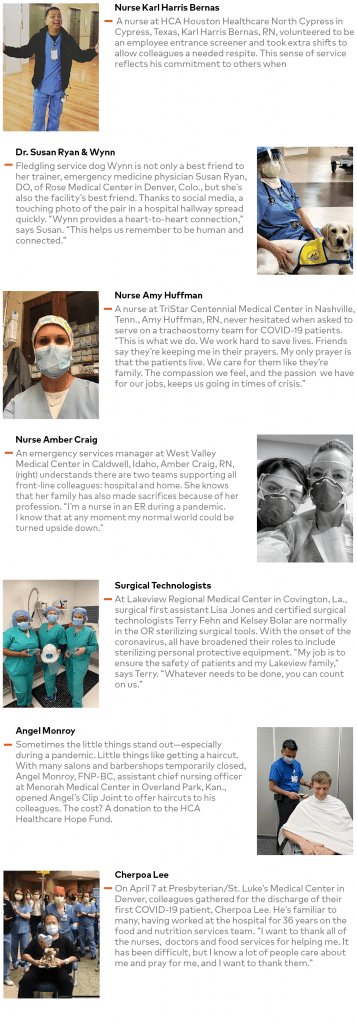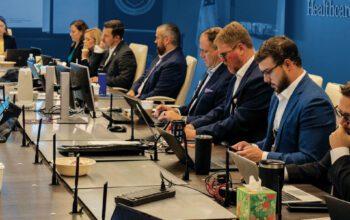Pandemic puts Enterprise Emergency Operations Center in the spotlight.


Mike Wargo’s job is to expect the unexpected. So when the dark clouds of the coronavirus began gathering in late December 2019, Mike, RN, BSN, MBA, PHRN, CMTE, HCA Healthcare’s vice president of Enterprise Preparedness & Emergency Operations, and his team acted quickly. The Enterprise Emergency Operations Center (EEOC)—part of the larger department that Mike oversees—mobilized with laser-sharp precision, transitioning from awareness to preparation to response.
“Before we identified our first patient in San Jose, California, our EEOC was activated, and directives were given for all facilities to activate their facility EOCs,” he says. “Readiness for a potential COVID-19 surge across the U.S. was the organization’s top priority.”
“It is quite amazing to see everyone coming together during this time. I am very proud to be a part of this amazing organization, especially in times like this, when the level of uncertainty is at an all-time high.”— Rose Amazan, BSN, RN Memorial Health University Medical Center Savannah, Ga.
Four priorities
In short, the EEOC is tasked with ensuring that leaders enterprise-wide have the resources needed for their facilities to provide “uninterrupted patient care and to fulfill our mission to our communities,” says Mike. The EEOC functions under an “all-hazards” approach, with four priorities that pertain to any hazardous situation.
The first priority is life safety. “We focus on the physical and emotional well-being of our patients and families, staff and families, and the community at large.”
The second priority is infrastructure, Mike says, “ensuring that we have the people, supplies, equipment and physical space required to deliver care or perform business functions.” Third is operations, ensuring the organization can care for patients, protect staff and respond to the greater needs of the community.
The final priority: delivering on our commitment to the care and improvement of human life. Mike adds that the priorities may take shape in different ways. “Our top life safety priority was to ensure that our staff had the appropriate personal protective equipment (PPE) and knew how to assess and care for patients to reduce their exposure to the virus.”

The Three C's
To address the EEOC’s four priorities, Mike says his team follows the three C’s:
Communication
In early January, with the virus likely to spread rapidly, HCA Healthcare began briefings with leadership and engaged all of our facilities about potentially activating their pandemic plans. “Each facility was asked to review their plan and let division EOC leadership know of any shortcomings,” says Mike.
Coordination
The EEOC held a TOPOFF (Top Officials) exercise to assess clinical surge operations and global supply chain, with emphasis on products from China, where so many are made. Our teams then took preparedness to another level by conducting a series of virtual tabletop exercises related to pandemic response and surge capacity, Mike explains.
“This helped our action planning on what areas needed the greatest focus and support from the corporate level.”
Collaboration
Fortunately, our organization’s sheer size and scale enables us to address big challenges. Based on early models estimating outbreaks, COVID-19 had the potential for what Mike calls a “mass surge” of patients across the communities we serve. That required a response on an enormous scale.
“Never have we been challenged so that all of our facilities and their staff and their families would be at risk, and the most-needed supply chain items were made and distributed from the global epicenter of the virus.”
Timing is Everything
Another major challenge: the unknown timeline created by the unpredictable nature of COVID-19. “At any time, this virus could have presented as one patient or a community outbreak,” says Mike. Enterprise-wide response was on several levels, he explains, primarily because “the virus spread quickly and very differently in each community. The challenge was to ensure every one of our facilities was prepared.”
We were able to scale testing and clinical capabilities, focusing on creating a safe environment, says Mike. “Alternate screening sites and teams were established to quickly protect all patients and staff, and to identify potential cases.”
Emergency response teams also helped set capacity plans and protocols to expand ICUs and ventilator capabilities. Moreover, use of data science teams allowed for the uniform assessment and a consistent operating picture that guided readiness plans. “Few organizations have the scope of data that we have in near real-time reporting,” says Mike.
Front-line Support
Throughout the coronavirus response, our executives and EEOC team members continue to work closely with the physicians, nurses and other colleagues who deal directly with patients. Julia Moody, MS SM (ASCP), CIC, senior director of infection prevention with our Clinical Services Group, says the EEOC’s emphasis on communication allows the organization to keep up with the most current recommendations.
“It’s so important to be able to listen to the front-line care- givers and get their feedback on what’s working and what’s not,” says Julia. “They’re very smart innovators who adapt quickly and share that innovation, so we can incorporate it in other divisions and facilities that are currently in surge.”
There’s no question that COVID-19 has had a tangible effect on every aspect of our organization. Patients and colleagues can take heart that we’re committed to care, regardless of the threat and when it may first occur—or return. The EEOC will make certain of it.



